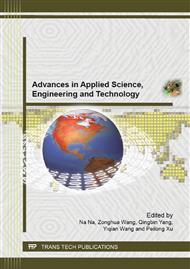[1]
Hibara, A., M. Tokeshi, K. Uchiyama, et al., Integrated multilayer flow system on a microchip. Analytical Sciences, 2001. 17(1): pp.89-93.
DOI: 10.2116/analsci.17.89
Google Scholar
[2]
Kikutani, Y., H. Hisamoto, M. Tokeshi, et al., Micro wet analysis system using multi-phase laminar flows in three-dimensional microchannel network. Lab on a Chip, 2004. 4(4): pp.328-332.
DOI: 10.1039/b400233d
Google Scholar
[3]
Tokeshi, M., T. Minagawa, K. Uchiyama, et al., Continuous-flow chemical processing on a microchip by combining microunit operations and a multiphase flow network. Analytical Chemistry, 2002. 74(7): pp.1565-1571.
DOI: 10.1021/ac011111z
Google Scholar
[4]
Tokeshi, M., T. Minagawa, and T. Kitamori, Integration of a microextraction system on a glass chip: Ion-pair solvent extraction of Fe(II) with 4,7-diphenyl-1,10-phenanthrolinedisulfonic acid and tri-n-octylmethylammonium chloride. Analytical Chemistry, 2000. 72(7): pp.1711-1714.
DOI: 10.1021/ac991147f
Google Scholar
[5]
Hisamoto, H., T. Horiuchi, K. Uchiyama, et al., On-chip integration of sequential ion-sensing system based on intermittent reagent pumping and formation of two-layer flow. Analytical Chemistry, 2001. 73(22): pp.5551-5556.
DOI: 10.1021/ac0107150
Google Scholar
[6]
Hotokezaka, H., M. Tokeshi, M. Harada, et al., System for high-level radioactive waste using microchannel chip - Extraction behavior of metal ions from aqueous phase to organic phase in microchannel. Progress in Nuclear Energy, 2005. 47(1-4): pp.439-447.
DOI: 10.1016/j.pnucene.2005.05.045
Google Scholar
[7]
Maruyama, T., H. Matsushita, J. Uchida, et al., Liquid membrane operations in a microfluidic device for selective separation of metal ions. Analytical Chemistry, 2004. 76(15): pp.4495-4500.
DOI: 10.1021/ac049844h
Google Scholar
[8]
Kagawa, T., M. Ohno, T. Seki, et al., Online determination of copper in aluminum alloy by microchip solvent extraction using isotope dilution ICP-MS method. Talanta, 2009. 79(4): pp.1001-1005.
DOI: 10.1016/j.talanta.2009.02.017
Google Scholar
[9]
Ohashi, A., M. Sugaya, and H.B. Kim, Development of a Microfluidic Device for Measurement of Distribution Behavior between Supercritical Carbon Dioxide and Water. Analytical Sciences, 2011. 27(6): pp.567-569.
DOI: 10.2116/analsci.27.567
Google Scholar
[10]
Hibara, A., M. Nonaka, H. Hisamoto, et al., Stabilization of liquid interface and control of two-phase confluence and separation in glass microchips by utilizing octadecylsilane modification of microchannels. Analytical Chemistry, 2002. 74(7): pp.1724-1728.
DOI: 10.1021/ac011038c
Google Scholar
[11]
Mu, X.A., Q.L. Liang, P. Hu, et al., Selectively modified microfluidic chip for solvent extraction of Radix Salvia Miltiorrhiza using three-phase laminar flow to provide double liquid-liquid interface area. Microfluidics and Nanofluidics, 2010. 9(2-3): pp.365-373.
DOI: 10.1007/s10404-009-0554-y
Google Scholar
[12]
Znidarsic-Plazl, P. and I. Plazl, Steroid extraction in a microchannel system - mathematical modelling and experiments. Lab on a Chip, 2007. 7(7): pp.883-889.
DOI: 10.1039/b704432a
Google Scholar


